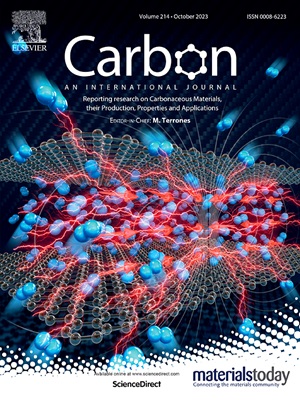Amino-functionalized graphene oxide nanocomposite as an efficient catalyst for the conversion of CO2 into oxazolidinone derivatives via a cascade reaction
IF 10.5
2区 材料科学
Q1 CHEMISTRY, PHYSICAL
引用次数: 0
Abstract
In this study, we present the functionalization of graphene oxide (GO) with 3-quinuclidinol (Qu) to create an amino-functionalized graphene oxide nanocomposite (GO-Qu) as a basic catalyst and its application in a cascade reaction for the synthesis of oxazolidinone compounds via a carboxylative cyclization method. The GO-Qu nanocomposite was synthesized from the functionalization of GO with 3-quinuclidinol and was entirely characterized using techniques such as energy dispersive spectroscopy (EDS), scanning electron microscopy (SEM), X-ray diffraction (XRD), Fourier-transform infrared (FT-IR) spectroscopy, and thermogravimetric analysis (TGA). The catalytic activity of the GO-Qu nanocomposite was evaluated in a cascade reaction involving a self-condensation reaction of a primary amine compound in the first stage, followed by the synthesis of the oxazolidinone product in the second stage through the addition of an arylacetylene derivative. This cascade reaction was carried out using the GO-Qu nanocomposite as a basic catalyst in the presence of CuI as a co-catalyst under solvent-free conditions. Initially, the self-condensation reaction of amine derivatives was performed under a dry air atmosphere (using a balloon) at 100οC, yielding imine intermediate compounds. Subsequently, this cascade reaction continued with the addition of arylacetylene to this mixture under an atmospheric pressure of CO2 gas (using a balloon) at 100οC. The corresponding oxazolidinone compounds were obtained with good to high yield (70-95 %) after 24 h. The reusability investigation of the GO-Qu nanocomposite showed that it could be recovered and recycled for five runs without a significant reduction in its catalytic activity.
氨基功能化氧化石墨烯纳米复合材料作为级联反应将二氧化碳转化为恶唑烷酮衍生物的有效催化剂
在本研究中,我们介绍了氧化石墨烯(GO)与3-喹啉二醇(Qu)的功能化,以制备氨基功能化氧化石墨烯纳米复合材料(GO-Qu)作为基本催化剂,并将其应用于通过羧化环化方法合成恶唑烷酮化合物的级联反应。采用3-喹啉二醇对氧化石墨烯进行功能化,合成了氧化石墨烯-qu纳米复合材料,并利用能谱(EDS)、扫描电镜(SEM)、x射线衍射(XRD)、傅里叶变换红外(FT-IR)光谱和热重分析(TGA)等技术对其进行了全面表征。通过级联反应对GO-Qu纳米复合材料的催化活性进行了评价,该级联反应首先是伯胺化合物的自缩合反应,然后在第二阶段通过添加芳基乙炔衍生物合成恶唑烷酮产品。在无溶剂条件下,以氧化石墨烯-氧化石墨烯纳米复合材料为基本催化剂,以崔为助催化剂,进行了级联反应。最初,胺衍生物的自缩合反应是在100οC的干燥空气气氛下进行的(使用气球),产生亚胺中间体化合物。随后,这个级联反应继续进行,在大气压力下(使用气球)在100οC的CO2气体中向混合物中添加芳基乙炔。24 h后得到了相应的氧唑烷酮化合物,收率达到70- 95%。对氧化石墨烯-氧化石墨烯纳米复合材料的可重复利用性研究表明,氧化石墨烯-氧化石墨烯纳米复合材料可以回收再利用5次,而催化活性没有明显降低。
本文章由计算机程序翻译,如有差异,请以英文原文为准。
求助全文
约1分钟内获得全文
求助全文
来源期刊

Carbon
工程技术-材料科学:综合
CiteScore
20.80
自引率
7.30%
发文量
0
审稿时长
23 days
期刊介绍:
The journal Carbon is an international multidisciplinary forum for communicating scientific advances in the field of carbon materials. It reports new findings related to the formation, structure, properties, behaviors, and technological applications of carbons. Carbons are a broad class of ordered or disordered solid phases composed primarily of elemental carbon, including but not limited to carbon black, carbon fibers and filaments, carbon nanotubes, diamond and diamond-like carbon, fullerenes, glassy carbon, graphite, graphene, graphene-oxide, porous carbons, pyrolytic carbon, and other sp2 and non-sp2 hybridized carbon systems. Carbon is the companion title to the open access journal Carbon Trends. Relevant application areas for carbon materials include biology and medicine, catalysis, electronic, optoelectronic, spintronic, high-frequency, and photonic devices, energy storage and conversion systems, environmental applications and water treatment, smart materials and systems, and structural and thermal applications.
 求助内容:
求助内容: 应助结果提醒方式:
应助结果提醒方式:


